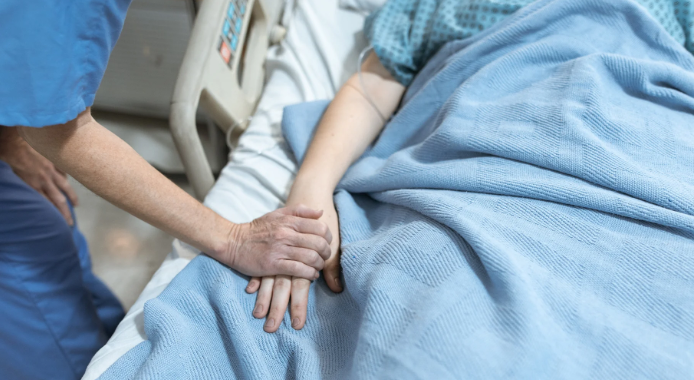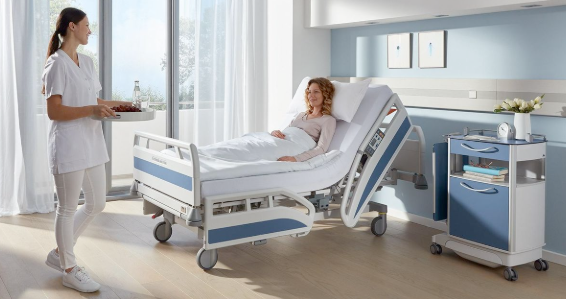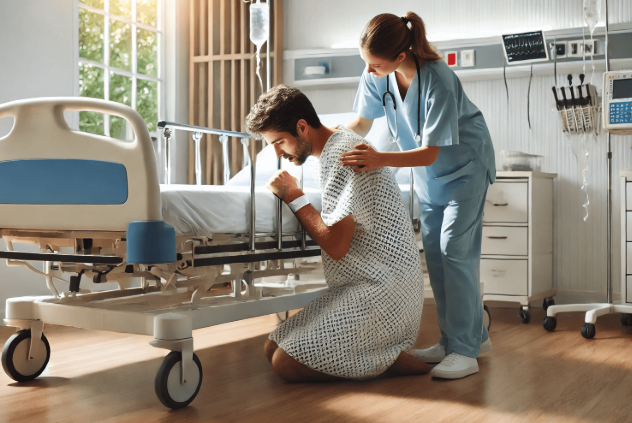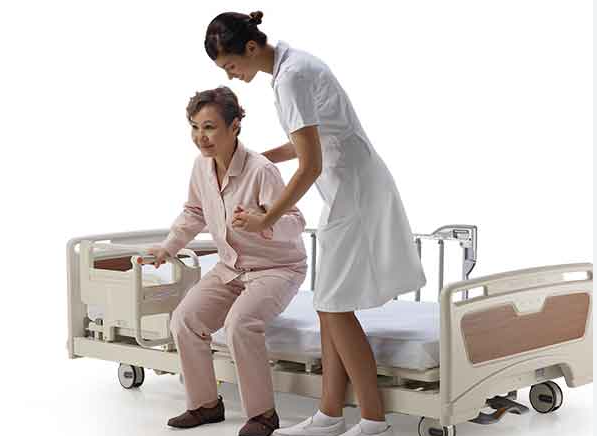What is the role of Hospital Beds in patient recovery?Hospital beds are more than just a place to rest. The right bed can impact a patient’s recovery. It can improve comfort and safety, both of which are crucial for healing. So, what makes a hospital bed effective for recovery? Let’s explore.
Improved Patient Comfort
The role of hospital beds in patient recovery-improved patient comfort
Hospital beds are more than just furniture—they are essential for patients recovering. The design of these beds plays a key role in how a patient feels during recovery. For those needing long-term care, a well-designed bed can provide more than comfort. It offers dignity and peace in tough times.
Bed Size and Weight Capacity
A properly sized bed gives patients enough room to move without feeling cramped. Beds with a higher weight capacity also improve comfort, particularly for heavier patients.
Adjustability and Customizable Positions
Hospital beds that produced by Grace Medy can adjust to different positions allow patients to find the most comfortable posture. This is helpful for people with breathing problems, sleep apnea, or those recovering from surgery. Raising the head or legs can ease discomfort, boost circulation, and speed up recovery.
Reducing Discomfort and Pain
The role of hospital beds in patient recovery is include reducing discomfort and pain. Hospital beds that offer enough space to move can reduce discomfort for patients recovering from surgery. Too little space can cause pain for patients undergoing abdominal surgery who need to avoid muscle strain.
Patient Autonomy
Hospital beds with easy-to-use controls let patients adjust their position based on their comfort. This freedom not only increases comfort but also boosts satisfaction, especially for long-term care patients who spend a lot of time in bed.
Safety and Comfort Integration
Safety features like adjustable heights and locking mechanisms keep beds stable and secure, reducing the risk of accidents. These features help create a safer and more comfortable environment, allowing patients to rest and recover without added stress.
Enhanced Safety and Prevention of Falls
The role of hospital beds in patient recovery-enhanced safety and prevention of falls
In hospitals, keeping patients safe from falls is a top priority. From my experience, a good hospital bed is essential for preventing accidents. A well-designed bed improves mobility and provides the necessary support. It helps cushion each movement, ensuring patients stay safe and comfortable while they heal.
Bed Height and Fall Prevention
Ultra-low hospital beds are key to reducing fall risks. Beds with a height of 21cm and a 14cm mattress provide the right height for patients to get in and out of bed safely. This setup allows over 99% of men and 96% of women to mobilize with their feet flat on the floor, which helps reduce the impact of any fall. Lowering the bed height also lessens the severity of a fall, making movement safer for patients.
Customizable Bed Heights
Adjustable bed heights meet the needs of different patients. Beds that can be set as low as 10 inches from the deck to the floor are especially useful for smaller patients, making it easier for them to get in and out of bed safely. For taller patients, hospital beds with smart screens allow height adjustments, offering a more comfortable and secure experience when moving.
Side Rails and Bed-Exit Detection Systems
Side rails are essential to prevent patients from rolling out of bed. Hospital beds that meet BS EN ISO 60601-2-52 standards ensure that side rails are the right height and design. Bed-exit detection systems with visual and audible alarms help healthcare staff monitor patient movements in real time. These alarms, linked to nurse call systems, have been shown to reduce fall events by up to 20% and fall-related injuries by up to 40%.
Ergonomic Design
An ergonomic bed design is important for safe patient exits. Beds with a clear space for the heels allow patients to move without obstruction. Handgrips on the side rails offer support for safely getting out of bed. These design features help reduce the risk of falls, allowing patients to move with more confidence and safety.
Support for Mobility and Physical Therapy
The role of hospital beds in patient recovery-Support for Mobility and Physical Therapy
Expert Opinion:
“In my experience, Adjustable hospital beds improve mobility and speed up recovery. These beds help patients move more easily and prevent stiffness from staying in bed too long. By adjusting the bed’s height and angle, patients can take an active role in their recovery. This can reduce the risk of complications like muscle weakness or blood clots after surgery.”
— Dr. John Smith, Orthopedic Specialist with 15 years of experience in patient recovery and rehabilitation.
Improving Patient Mobility
Adjustable hospital beds make it easier for patients to get in and out of bed. By adjusting the bed’s height and incline, patients can reduce stiffness and boost blood flow, which helps them recover faster. These exercises reduce the risk of post-operative complications and speed up healing.
Facilitating Physical Therapy
Hospital beds with adjustable features offer the stability needed for safe physical therapy. Patients can perform exercises that improve strength, balance, and mobility. The ability to adjust the bed makes it easier for patients to follow their therapy plans, leading to better recovery results.
Customized Positioning for Therapy
Adjustable hospital beds let patients set their position based on comfort and therapy needs. For instance, raising the head or legs helps patients do physical therapy exercises, especially after surgeries like orthopedic procedures.
Ease of Transfers
Hospital beds with assist rails and hi-lo features help patients reposition themselves easily. These features are especially helpful for those recovering from knee replacements or similar surgeries, as they make it safer to transfer to chairs or walk to rebuild strength.
Preventing Muscle Atrophy and Complications
Hospital beds allow for regular movement, which helps prevent muscle atrophy in bedridden patients. Shifting positions also lowers the risk of pressure ulcers and other complications.
Enhancing Circulation and Respiratory Function
Adjusting the bed to raise different body parts promotes healthy blood flow and improves breathing. These benefits are especially important for patients recovering from surgeries or injuries that limit their mobility.
Prevention of Postoperative Complications
The role of hospital beds in patient recovery-Prevention of Postoperative Complications
Hospital beds play a key role in the recovery process. They support your body in just the right way, helping you move comfortably. This firm yet gentle support makes it easier to rest and speeds up your recovery. Choosing the right bed gives you the best chance to recover quickly and lowers the risk of setbacks.
| Aspect | Details |
|---|---|
| Preventing Pressure Ulcers and Bedsores | Hospital beds with adjustable positions reduce pressure on sensitive areas, helping prevent pressure ulcers and bedsores. These beds support skin health by allowing patients to change positions and avoid staying still for too long. |
| Preventing Deep Vein Thrombosis (DVT) | Adjustable hospital beds promote regular movement, helping prevent stiffness and improving blood flow. This aids in faster recovery and reduces the risk of Deep Vein Thrombosis (DVT), common after surgery. |
| Preventing Respiratory Complications | Hospital beds make it easier for patients to get up and move around, which helps prevent respiratory issues like pneumonia. Programs like I COUGH recommend patients get out of bed at least three times a day and raise the head of the bed to reduce the chances of pneumonia and the need for intubation. |
| Preventing Physical Deconditioning | Beds designed for movement help prevent muscle loss and physical weakness. Features like adjustable height and incline make it easier for patients to get in and out of bed, reducing risks associated with prolonged bed rest. |
| Preventing Swelling and Blood Pressure | Hospital beds assist in managing swelling and blood pressure changes, particularly for patients recovering from leg surgeries. By raising the legs, these beds improve fluid circulation, reducing swelling and enhancing comfort during recovery. |
| Overall Recovery | Specialized hospital beds aid both physical recovery and rehabilitation. With features that support comfort, mobility, and safety, these beds help patients regain strength and independence more quickly, preventing long-term disability and improving recovery outcomes. |
Hospital beds provide better support for caregivers
The role of hospital beds in patient recovery-provide better support
Hospital beds that adjust are a major benefit for caregivers. I’ve seen how these beds really ease the burden they carry. Instead of bending and lifting all the time, caregivers can adjust the bed’s position. This helps them maintain good posture. It’s like having an extra set of hands, without the back pain. I can imagine how much relief this brings, allowing caregivers to stay calm and focused while providing the best care possible.
Key benefits for caregivers
- Reduced physical strain: Adjustable features allow caregivers to change the bed’s position without bending or lifting.
- Better ergonomics: The bed can be adjusted to support proper body posture, helping to reduce fatigue.
- Enhanced efficiency: The ability to adjust the bed quickly and easily makes patient care more effective with less effort.
Summary
The role of hospital beds in patient recovery is crucial. It makes a big difference in how fast and smooth the healing process is. That’s why it’s important to choose a reliable manufacturer. In my experience, a trustworthy hospital bed supplier ensures a smooth procurement process and high-quality products for any hospital project.
Grace Medy has been a trusted name for over 15 years. They specialize in hospital beds and offer other essential equipment, including medical trolleys, Operating tables, surgical lights,hospital chairs, Wheelchairs, and walking aids. What I appreciate about them is that they can offer a complete solution for your entire hospital project, making everything more efficient and easier. It’s like having a partner who supports you every step of the way.




